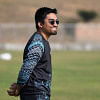Beyond cricket: A rare experience at the Wagah border ceremony

As a sports journalist, the job often takes you to stadiums, training grounds, and press conferences. But every now and then, an assignment leads to something far beyond the world of sports -- something that lingers in memory, offering a glimpse into history and culture.
While covering the ICC Champions Trophy in Pakistan, this reporter found experienced just that -- witnessing the iconic Wagah Border Parade, a spectacle of military precision, rivalry, and tradition that has captivated audiences for decades.
Wagah Border is situated around 25 km away from Lahore city, and the distance from here to India's Amritsar is also nearly similar – around 31 km.
This is one of the most key borders between the arch-rival nations, and apart from a land border, there is also an operational railway line between the two countries. The Samjhauta Express operates on the Delhi-Lahore route, carrying both passengers and freight.
When this reporter reached Lahore – the second-largest city in Pakistan – from its capital, Islamabad, by that time, the Bangladesh cricket team had already reached home after a disappointing campaign in the event, while the city was preparing for the second semi-final match.
However, as none of the semi-finalists had reached the city due to schedule-related complications, the touring Bangladeshi group of journalists had a reasonable amount of time to make plans to experience something really momentous besides their daily responsibilities.
On Monday, March 3, this reporter, along with a few other journalists from the Bangladesh contingent, planned to visit the famous Wagah Border.
Wagah Border is such a place where both India's BSF and Pakistan Rangers have demonstrated their individual power and supremacy since 1959 through a ceremony. It is also a symbol of brotherhood alongside the rivalry they have possessed for years.
The ritual flag-lowering ceremony takes place at 4:15 pm (winter) and 5:15 pm (summer) before sunset. The ceremony is held at the India-Pakistan border, specifically between Attari, India, and Wagah, Pakistan.
Although the winter season is ongoing, the ceremony started 15 minutes later than the scheduled time.
Before entering the Pakistani premises of the ceremony, one can notice from a 6.5 km distance that a gigantic Indian flag is waving, which may give anyone the virtual deception that the flag is in Pakistan.
However, when someone gets closer to the seating area, they can understand that the flag is waving on the Indian side.
The reporter was left awestruck when he witnessed that the Indian side was jam-packed with around 3,000 spectators in the galleries, dancing and singing before the start of the show.
However, it was totally different on the other side, as only a handful -- 100-200 people -- were sitting on this side. Along with the Pakistani natives, there were seven Bangladeshi journalists and a few Chinese people as well.
The understandable reason for the majority of the chairs being empty was that gallery renovation work had been ongoing for the last year, and it may take another one or two years to complete the project, according to a Pakistani Rangers female officer.
Just before the start of the ceremony, an ICC delegation team comprising their media team, broadcast team, and commentary team arrived at the location and was escorted by armed military personnel.
Later, talking to this reporter, ICC Media team's Sipokazi Sokanyile shared her experience there:
"It was a wonderful experience. Can't ask for a better show," Sipokazi said.
The ceremony begins with battle calls from the BSF and Pakistan Rangers in the form of loud screaming.
This is followed by a series of organised high kicks, stomps, and dance moves, during which the opposing forces stare each other down.
There are a few other segments as well in the ceremony, and the 40-minute-long event finally ends with a handshake by the head guards, along with the lowering of the flags.
For anyone visiting this part of the world, the Wagah Border Parade is more than just a ceremony; it is a once-in-a-lifetime experience. And for this reporter, it is a memory to be cherished forever.

 For all latest news, follow The Daily Star's Google News channel.
For all latest news, follow The Daily Star's Google News channel. 



Comments